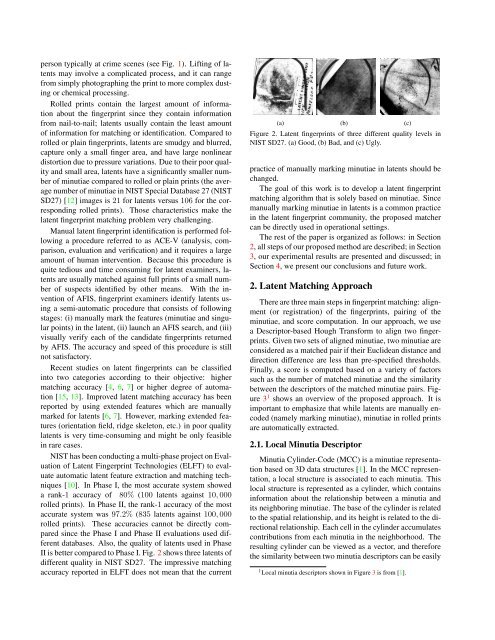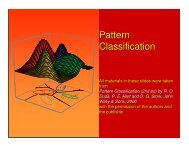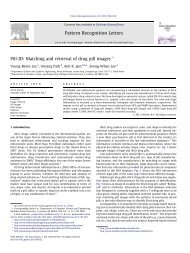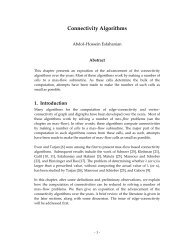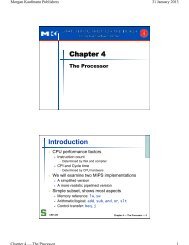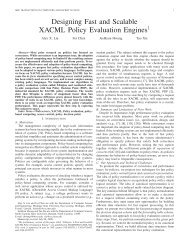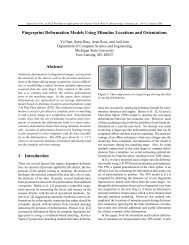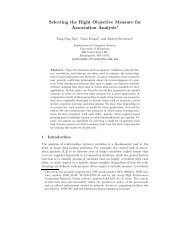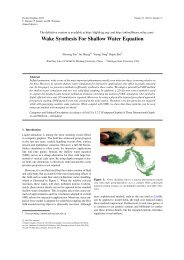Latent Fingerprint Matching using Descriptor-Based Hough Transform
Latent Fingerprint Matching using Descriptor-Based Hough Transform
Latent Fingerprint Matching using Descriptor-Based Hough Transform
You also want an ePaper? Increase the reach of your titles
YUMPU automatically turns print PDFs into web optimized ePapers that Google loves.
person typically at crime scenes (see Fig. 1). Lifting of latents<br />
may involve a complicated process, and it can range<br />
from simply photographing the print to more complex dusting<br />
or chemical processing.<br />
Rolled prints contain the largest amount of information<br />
about the fingerprint since they contain information<br />
from nail-to-nail; latents usually contain the least amount<br />
of information for matching or identification. Compared to<br />
rolled or plain fingerprints, latents are smudgy and blurred,<br />
capture only a small finger area, and have large nonlinear<br />
distortion due to pressure variations. Due to their poor quality<br />
and small area, latents have a significantly smaller number<br />
of minutiae compared to rolled or plain prints (the average<br />
number of minutiae in NIST Special Database 27 (NIST<br />
SD27) [12] images is 21 for latents versus 106 for the corresponding<br />
rolled prints). Those characteristics make the<br />
latent fingerprint matching problem very challenging.<br />
Manual latent fingerprint identification is performed following<br />
a procedure referred to as ACE-V (analysis, comparison,<br />
evaluation and verification) and it requires a large<br />
amount of human intervention. Because this procedure is<br />
quite tedious and time consuming for latent examiners, latents<br />
are usually matched against full prints of a small number<br />
of suspects identified by other means. With the invention<br />
of AFIS, fingerprint examiners identify latents <strong>using</strong><br />
a semi-automatic procedure that consists of following<br />
stages: (i) manually mark the features (minutiae and singular<br />
points) in the latent, (ii) launch an AFIS search, and (iii)<br />
visually verify each of the candidate fingerprints returned<br />
by AFIS. The accuracy and speed of this procedure is still<br />
not satisfactory.<br />
Recent studies on latent fingerprints can be classified<br />
into two categories according to their objective: higher<br />
matching accuracy [4, 6, 7] or higher degree of automation<br />
[15, 13]. Improved latent matching accuracy has been<br />
reported by <strong>using</strong> extended features which are manually<br />
marked for latents [6, 7]. However, marking extended features<br />
(orientation field, ridge skeleton, etc.) in poor quality<br />
latents is very time-consuming and might be only feasible<br />
in rare cases.<br />
NIST has been conducting a multi-phase project on Evaluation<br />
of <strong>Latent</strong> <strong>Fingerprint</strong> Technologies (ELFT) to evaluate<br />
automatic latent feature extraction and matching techniques<br />
[10]. In Phase I, the most accurate system showed<br />
a rank-1 accuracy of 80% (100 latents against 10, 000<br />
rolled prints). In Phase II, the rank-1 accuracy of the most<br />
accurate system was 97.2% (835 latents against 100, 000<br />
rolled prints). These accuracies cannot be directly compared<br />
since the Phase I and Phase II evaluations used different<br />
databases. Also, the quality of latents used in Phase<br />
II is better compared to Phase I. Fig. 2 shows three latents of<br />
different quality in NIST SD27. The impressive matching<br />
accuracy reported in ELFT does not mean that the current<br />
(a) (b) (c)<br />
Figure 2. <strong>Latent</strong> fingerprints of three different quality levels in<br />
NIST SD27. (a) Good, (b) Bad, and (c) Ugly.<br />
practice of manually marking minutiae in latents should be<br />
changed.<br />
The goal of this work is to develop a latent fingerprint<br />
matching algorithm that is solely based on minutiae. Since<br />
manually marking minutiae in latents is a common practice<br />
in the latent fingerprint community, the proposed matcher<br />
can be directly used in operational settings.<br />
The rest of the paper is organized as follows: in Section<br />
2, all steps of our proposed method are described; in Section<br />
3, our experimental results are presented and discussed; in<br />
Section 4, we present our conclusions and future work.<br />
2. <strong>Latent</strong> <strong>Matching</strong> Approach<br />
There are three main steps in fingerprint matching: alignment<br />
(or registration) of the fingerprints, pairing of the<br />
minutiae, and score computation. In our approach, we use<br />
a <strong>Descriptor</strong>-based <strong>Hough</strong> <strong>Transform</strong> to align two fingerprints.<br />
Given two sets of aligned minutiae, two minutiae are<br />
considered as a matched pair if their Euclidean distance and<br />
direction difference are less than pre-specified thresholds.<br />
Finally, a score is computed based on a variety of factors<br />
such as the number of matched minutiae and the similarity<br />
between the descriptors of the matched minutiae pairs. Figure<br />
3 1 shows an overview of the proposed approach. It is<br />
important to emphasize that while latents are manually encoded<br />
(namely marking minutiae), minutiae in rolled prints<br />
are automatically extracted.<br />
2.1. Local Minutia <strong>Descriptor</strong><br />
Minutia Cylinder-Code (MCC) is a minutiae representation<br />
based on 3D data structures [1]. In the MCC representation,<br />
a local structure is associated to each minutia. This<br />
local structure is represented as a cylinder, which contains<br />
information about the relationship between a minutia and<br />
its neighboring minutiae. The base of the cylinder is related<br />
to the spatial relationship, and its height is related to the directional<br />
relationship. Each cell in the cylinder accumulates<br />
contributions from each minutia in the neighborhood. The<br />
resulting cylinder can be viewed as a vector, and therefore<br />
the similarity between two minutia descriptors can be easily<br />
1 Local minutia descriptors shown in Figure 3 is from [1].


